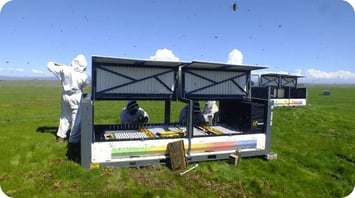CEO Statement
Dear fans of bees (and …food),
When my co-founders and I founded Beewise over six years ago, global bee colony collapse rates were already alarmingly high—hovering in the upper 30% range. Even then, we believed these numbers represented an urgent and existential threat to global food security; unfortunately, things have only worsened since..
2024 was particularly devastating: reports indicate that the United States experienced an average colony collapse rate of 62%, significantly intensifying crop shortages and disrupting entire agricultural ecosystems. This sharp rise in bee mortality underscores just how urgent and essential our founding mission has become.
If you attended any agricultural trade shows this year, you likely witnessed the rapid rise of data-driven, autonomous technologies—applied everywhere from tractors to crop-sorting machinery. Yet pollination has lagged behind. Until recently, growers had no choice but to rely on a hive design that hasn't fundamentally changed since the 1800s.
Traditional hives require labor-intensive, manual inspections and in-field interventions, offering no visibility into hive health. This leaves both beekeepers and crop growers blind to the challenges their bees are facing. As a result, colonies remain highly vulnerable to threats like temperature extremes, pesticides, and diseases—without any means of remote monitoring or treatment.
Lately, we’ve seen efforts to retrofit conventional wooden hives with sensors. While these upgrades offer limited insights into metrics like sound, and weight, and more, they don’t address the root problem; even with accurate data, beekeepers must still perform labor-intensive, in-field, costly treatments—a model that is neither scalable nor sustainable. It’s no surprise, then, that colony collapse rates continue to exceed 60% year after year.
That’s why we developed Active Beekeeping—a leap forward that leverages AI, precision robotics, and computer vision to enable remote inspections, hive grading, and, most importantly, real-time interventions. For example, growers can now close hive entrances directly from their phone to shield bees from pesticide exposure—delivering a truly remote and integrated pest management solution. Beekeepers can feed their bees remotely, provide them water, and a plethora of other treatments, all administered remotely from their phone.
We are just at the beginning of what Active Beekeeping can achieve. As the technology matures and research scales, new capabilities will emerge. One thing is clear: Active Solutions are the only viable path forward in a world facing growing labor shortages, worsening colony collapse, and increasingly unpredictable climate conditions.
Saar Safra

Our Momentum in 2024
.png?width=225&height=225&name=email%20graphic%20(2).png)

.png?width=225&height=225&name=email%20graphic%20(1).png)
Read the Full Report
You can read the full report at beewise.ag/impact. If you are a grower interested in working with Beewise on pollination, a commercial beekeeper interested in using BeeHomes™ in your operations, or a corporate sustainability leader interested in bringing BeeHomes™ to your campus, please get in touch.
.jpg?width=50&name=Saar%20Safra-%20CEO%20%26%20Co-Founder.headshot%20(2).jpg)
.jpg)
.jpg?width=355&height=199&name=DSC00415%20(1).jpg)


.png?width=355&height=199&name=Copy%20of%20The%20Evolution%20of%20Pollination%20(1).png)
Leave comment